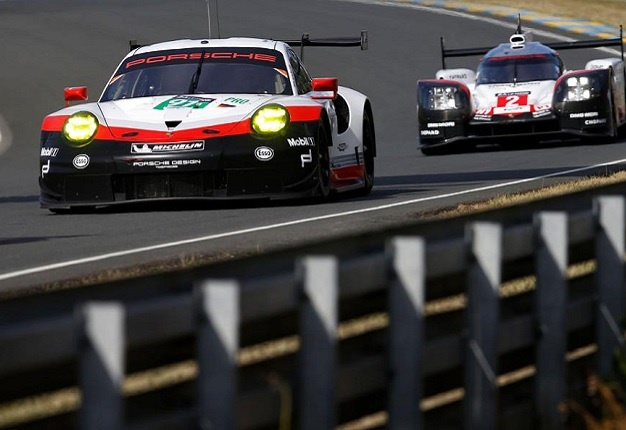
Paris - You’ve driven the 13.629km track on Gran Turismo and Forza. You know the name of every corner of racing’s most revered road – and which Bentleys are named after them. Your dog is called Steve McQueen. The digits “962” gets your blood pumping harder than a naked Kim Kardashian selfie…
You’ve watched Truth in 24 and Truth in 24 II. You drive an Audi A3 TDI; and your wife a Prius or a Panamera Hybrid. Because Le Mans. Because only once a year. Or. Just. Because. Greatest motorsport event in the world.
World’s toughest endurance race
First off in 2017, though, it’s impossible to mull over the full meaning of Le Mans without contemplating the indelible mark that Audi has left on the world’s toughest endurance race over the past 16 years. From the big, filthy 5.5-litre V12 R10 TDI torque-tank of the mid-2000s, to the ultra-efficient hybrid R18 e-tron jet fighter of the latter years, the motorsport world witnessed the introduction an unprecedented level of innovation and professionalism to top-flight prototype sportscar racing.
That all ended at the end of the 2016 – abruptly if not entirely unsurprisingly – when the fallout from Dieselgate that rendered compression engines unsellable and a $15-billion fine in the US left the under-pressure VW Group little choice but to pull the plug on the Audi’s Le Mans prototype project. The LMP1 category was left decidedly poorer, along with an irreparable crater-sized hole in the hearts of adoring disciples.
It hardly bears saying, but Audi will be missed.
Except perhaps by Toyota, now alone in tasked with taking on the might of the most successful marque in the sport’s history – defending champions Porsche, who has won Le Mans 18 times. The harrowing emptiness felt following Audi’s departure is only matched by the despair that the Japanese team experienced after losing the race to Porsche on the second-last lap of 2016’s race.
And it was a repeat of the cruel luck the team endured first when closing to within a hair’s breadth of winning in 1999 before suffering a puncture, followed by more heartache when their car caught fire while comfortably leading in 2014. Surely, somewhere in Japanese folklore, it must be written that bad luck comes in threes at Le Mans.
And it could well be a prophecy that rings true, in 2017, because first qualifying on Wednesday evening has seen the fastest Porsche almost a full second adrift of Toyota’s provisional pole time 3.18.793, at an average speed of 246.8km/h.
Even Toyota themselves – covering every single eventuality by entering three cars as opposed to Porsche’s two – are now confident enough to openly admit that it’s going to be hard to bet against them come Sunday 3PM when the chequered flag falls. After all, they’ve won the season’s two preceding races at Silverstone and Spa. This must be their moment to shine.
PICS: 7 cars LeMans racers drive in their spare time!
LMP2 category
About ten seconds per laps lap slower is the LMP2 category, an all-privateer class in which all teams are mandated use the same engine and choose of one of five chassis. Admittedly, mandatory use of specification parts are a spectator yawn-fest slam-dunk (think “Global Touring Cars” in South Africa, that’s if ever you’ve heard of it), but amazingly, following the Le Mans test day last Sunday, the LMP2s were faster at the end of the straights (340+ km/h) than the LMP1s (336km/h). Which means that although the hybrid LMP1s remain somewhat faster around other parts of the lap, overtaking will be a more intimate affair.
GTE class
What’s left is the GTE class, split into PRO and AM, the latter two distinguished by the age of the car and skill of the driver line-up. It’s the class with the most active manufacturer involvement, with Porsche, Aston Martin, Corvette, Ferrari along with last year’s cheating-within-the-rules class winners Ford all entering factory or semi-factory efforts. BMW will join them next year in the newly-unveiled M8.
With tightly controlled performance parameters through a sometimes controversial system called Balance of Performance, these semi-production cars race nose-to-tail for hours on end with nothing to choose between them. As the slowest cars on track (35+ seconds per lap slower than the LMP1s), they are also the ones complicating the lives of the faster ones that need to get by with the minimum loss of time or effort.
Who will see the chequered flag first on Sunday? A dry race has been predicted for the first time in 12 years, which arguably removes certain strategic options from the table. However, someone once said, “you don’t go to win at Le Mans. Le Mans chooses you.”
The 24 hours of Le Mans starts at 15:00 on Saturday. Watch all 24 hours on DSTV Supersport 6. Download and print your free spotter’s guide.




 Publications
Publications
 Partners
Partners














